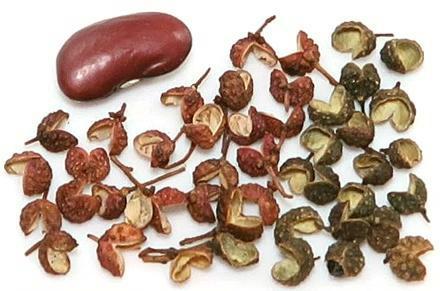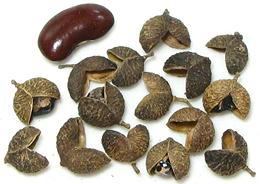Sichuan Peppercorns
 [Szechwan Peppercorns, Flower Pepper, Prickly Ash (English); Teppal
(India); Jiao (China) Zanthoxylum bungeanum,
Z. piperitum, Z. simulans and others (citrus family)]
[Szechwan Peppercorns, Flower Pepper, Prickly Ash (English); Teppal
(India); Jiao (China) Zanthoxylum bungeanum,
Z. piperitum, Z. simulans and others (citrus family)]
These "peppercorns" are dried fruits of prickly ash trees. They are
essential to the famous Sichuan cuisine of China and are used in other
cuisines. The Chinese variety come in red (left in photo) and green
(right in photo), but the green are still very rare here in North America
(2020). The two are very similar, though the green has a touch of lime
peel flavor and may be just a little stronger. Its use only started in
Sichuan in 1998, and it is now favored for river fish, eels and rabbit.
The empty seed pods are used, the seeds themselves are hard, have
little flavor, and are discarded. These pods are quite unique with a
remarkably sharp, citrusy flavor and a numbing anesthetic effect on the
tongue. Other countries, particularly Nepal, Bhutan and Tibet, use
related species with flavors that vary more or less from the Chinese.
Some of these are listed below.
More on Spices |
More on Citrus
 Sichuan Peppercorns were banned in the U.S. from 1968 to 2005 as a
possible carrier of citrus canker, but real enforcement didn't start
until 2002 - then supplies started to dry up. They are now legally
available again and in good supply. Current regulations require heating
the peppercorns to 160°F/70°C after which they will be somewhat
less red in color. There has been debate about how much this affects the
flavor, but Sichuan recipes generally call for them to be toasted before
use anyway, so this debate seems irrelevant.
Sichuan Peppercorns were banned in the U.S. from 1968 to 2005 as a
possible carrier of citrus canker, but real enforcement didn't start
until 2002 - then supplies started to dry up. They are now legally
available again and in good supply. Current regulations require heating
the peppercorns to 160°F/70°C after which they will be somewhat
less red in color. There has been debate about how much this affects the
flavor, but Sichuan recipes generally call for them to be toasted before
use anyway, so this debate seems irrelevant.
The empty fruit shells are much used in Sichuan China and in the
Himalayan region (Nepal, Tibet, Bhutan). In Japan, young leaves are
also used as a flavoring for fish, soups, and vegetables. In general
the fruits are dry roasted and then ground before adding to the recipe,
usually near the end of cooking.
Subst: There is no real substitute, but if you can't get them
use this formula: Grind together 1/2 t black peppercorns
and 2 t coriander seeds. Add grated zest of 2/3 lemon (yellow only). This
will fill in for about an equal measure of whole sichuan peppercorns. While
it lacks the important numbing effect it will fill in for the flavor.
Photo by Didier Descouens distributed under license
Creative Commons
Attribution-ShareAlike v 4.0 International.
Varieties
China: Shanjiao, Jaio, Fajiu (Canton)
(Z. bungeanum, Z. simulans), are used mostly in Sichuan
provence but also feature in Five Spice Powder, used throughout
China and Southeast Asia.
Nepal: Timur (Z. alatum) is a species important
to the cooking of Nepal, Bhutan, and Tibet. It's flavor differs a bit
from the Chinese in being less citrusy and more spicy, but it's pretty
much unavailable in North America, so use Chinese.
Korea: Sancho (Z. schinifolium) is used in
Korea. It is smaller than Chinese, green in color and has little
pungency. Koreans also use Chopi (Z. piperitum - see Japan).
Japan: Milder species are used in Japan, particularly
Sansho (Z. piperitum syn. Z. sansho). Young leaves
(kinomie) are also used as garnish for fish and as a flavoring in soups.
They are said to have a flavor somewhere between lime and mint. They
are also crushed with miso, then used in salads and with seafood and
vegetables. Green berries are often steeped in soy sauce and used with
fish. Inuzansho (Dog Sansho; Z. schinifolium) is also used.
 India: (photo to the left) Tirphal, Teppal, Tilfda,
Tippal, Tirphul (Z. rhetsa), is much larger than other species,
and green in color. It has much less of the tongue numbing effect than
the Sichuan species.
India: (photo to the left) Tirphal, Teppal, Tilfda,
Tippal, Tirphul (Z. rhetsa), is much larger than other species,
and green in color. It has much less of the tongue numbing effect than
the Sichuan species.
Indonesia: Andaliman (Z. acanthopodium) is
smaller than the others and often sold as clusters. It is less pungent
than the Chinese and very citrusy.
Tibet: g.yer ma (Z. alatum) is one of the few
spices available in the Himalayan region. It is used with yak meat and
yak innards.
U.S. Prickly ash (Z. americanum) has not been
used as a seasoning but its anaesthetic properties have been applied in
toothache potions.
U.S. Fagara (Z. bungeanum) an obsolete
market name for Sichuan peppercorns, apparently a corruption of the
Cantonese Fajiu. Most Chinese immigrants in the 19th to the mid 20th
centuries were from the Canton region.
sp_sichuanz 08 r 200113 - www.clovegarden.com
©Andrew Grygus - agryg@clovegarden.com - Photos on
this page © cg1 - Linking to and
non-commercial use of this page permitted
 Sichuan Peppercorns were banned in the U.S. from 1968 to 2005 as a
possible carrier of citrus canker, but real enforcement didn't start
until 2002 - then supplies started to dry up. They are now legally
available again and in good supply. Current regulations require heating
the peppercorns to 160°F/70°C after which they will be somewhat
less red in color. There has been debate about how much this affects the
flavor, but Sichuan recipes generally call for them to be toasted before
use anyway, so this debate seems irrelevant.
Sichuan Peppercorns were banned in the U.S. from 1968 to 2005 as a
possible carrier of citrus canker, but real enforcement didn't start
until 2002 - then supplies started to dry up. They are now legally
available again and in good supply. Current regulations require heating
the peppercorns to 160°F/70°C after which they will be somewhat
less red in color. There has been debate about how much this affects the
flavor, but Sichuan recipes generally call for them to be toasted before
use anyway, so this debate seems irrelevant. [Szechwan Peppercorns, Flower Pepper, Prickly Ash (English); Teppal
(India); Jiao (China) Zanthoxylum bungeanum,
Z. piperitum, Z. simulans and others (citrus family)]
[Szechwan Peppercorns, Flower Pepper, Prickly Ash (English); Teppal
(India); Jiao (China) Zanthoxylum bungeanum,
Z. piperitum, Z. simulans and others (citrus family)]
 India: (photo to the left) Tirphal, Teppal, Tilfda,
Tippal, Tirphul (Z. rhetsa), is much larger than other species,
and green in color. It has much less of the tongue numbing effect than
the Sichuan species.
India: (photo to the left) Tirphal, Teppal, Tilfda,
Tippal, Tirphul (Z. rhetsa), is much larger than other species,
and green in color. It has much less of the tongue numbing effect than
the Sichuan species.